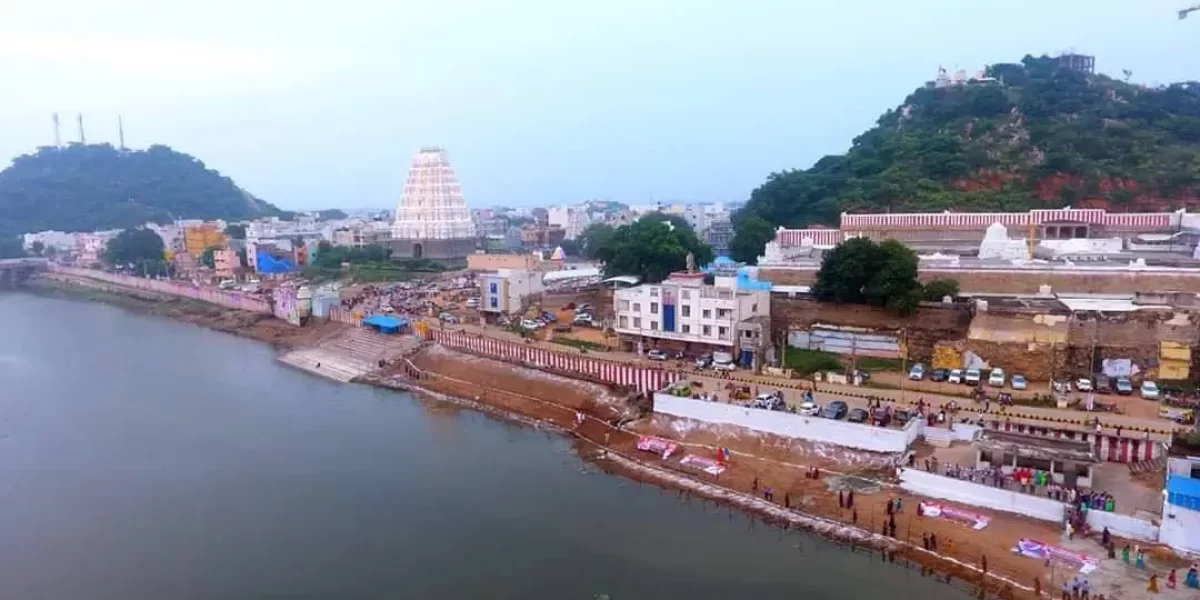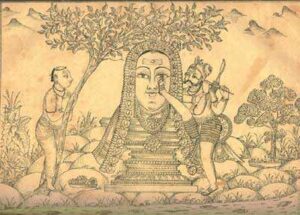Complete Guide about SriKalaHasti Temple
-
Location
Srikalahasti Temple, Srikalahasti, Andhra Pradesh 517644
-
Timings
Every Day
05:00am - 09:00 pm -
Entry Fee
No Entry fee
For Abhishekam : 600 INR
For Suprabhata Seve : 50 INR
For Archana : 25 INR
For Gomatha Pooja : 50 INR Per Head


SriKalaHasti Temple
About SriKalaHasti Temple
The temple itself is a magnificent work of architecture. Explore the temple for a while. Because they were protected by nature from deterioration, you can see that the interior pillars are as new as they were hundreds of years ago.
Because the outer temple was built in the 12th century by the Chola kings and the Vijayanagara kings, and the inner temple was built sometime in the fifth century, please plan your trip so that you can spend some time admiring the temple’s aesthetic and spiritual beauty.
Vayu is revered as Kalahasteeswara and takes the form of Lord Shiva.
You will see the old idol of SriGnanaprasunambika Devi (the original one) at the outer temple on your left as soon as you reach the temple gates (behind the shops). This idol was placed outside owing to various circumstances.
Many people continue to pray for it.
Even priests refrain from touching the main linga, which has never been touched by human hands. Pouring a mixture of water, milk, camphor, and panchamrita is how abhishek (bathing) is done. Instead of the main linga, the utsava-murti is offered sandal paste, flowers, and the sacred thread. The temple is entirely carved, and it has a huge, historic gopuram that is 36.5 metres (120 feet) high over the main gate.
Srikalahasti Temple Official Website Link : Click Here
The History
For little more than two thousand years, Sri Kalahasti has been referred to as the “Kailas of the South” and the small river on whose banks it is located as the “Ganges of the South,” according to ancient Tamil sources. India’s most venerated spiritual icon is likely Kailas. It is the home of Shiva, from whose head the Ganges is said to flow in legend. Shiva is a representation of the Self, and the Ganges flowing from his head is a metaphor for the spiritualized or awakened mind. Shiva is described as “that which is auspicious at all places, times, and in all circumstances.” A mind that draws its power and goodness from Spirit is a river of unfathomable strength and goodness.
The phrase “Kailas of the South” simply refers to the little hill next to the temple as the spiritual counterpart of the Himalayan Kailas. The little river that flows northward next to the temple is to be regarded as the powerful Ganges.
In Pauranic civilization, even the cardinal directions have taken on symbolic meaning. North, for instance, is said to be the abode of the Self because from the immortal “northern” position the Self looks out on the “southern” world of time and death. Of course, context should be taken into consideration when interpreting a symbol. The phrase “head south” denotes a downward slope or decay.
The Kalahasti Temple’s idol of the god Dakshinamurthy, whose name means “the one looking south,” sits in the north and faces south. The advent of wisdom is frequently represented by the east, and the sun is another well-known Self sign. The idea of constructing temples at the point on a river where its meandering points it back to its source is the culmination of the symbolic use of direction. The idea behind Benaras, the holiest city in India, is that when the mind returns to its source, the God/Self, it realises its inherent divinity. Benaras is situated on a section of the Ganges that flows northward.Because of the Ganges and the numerous spiritual emotions it evokes, the little river on whose banks the Kalahasthi temple is located is designed to serve as a reminder of those associations.
According to the Vedas, human beings seek happiness for four reasons: pleasure (kama), safety or prosperity (artha), responsibility (dharma), and freedom (artha) (moksha). According to temple literature, these four universal motivations—which might manifest in any worldly form—are transformed into spiritual impulses in the Kalahasti temple. Four deities facing the four cardinal directions serve as their representation. Although he is most often stated to represent the sense of richness (dakshina) that comes from realising who you are, Shiva in the guise of Dakshinamoorthy represents desire, in this case the desire for emancipation. The Goddess Gnanaprasoonamba, also known as the mother of all knowledge, represents the “wealth,” or liberation from restriction, bestowed by Self knowledge, in Kalahasti.The liberation-symbolizing deity Kalahastishwara (the lord of Kalahasti) faces west. The last phase of life is liberation, which is the death of ego upon the rediscovery of the Self, much as setting is the sun’s final act before it goes over the horizon.
This temple has received numerous gifts from both the Vijayanagara Rulers and the Tamil Cholas. It is said that Adi Sankara visited this temple and performed worship there. This temple contains Chola inscriptions that date to the 10th century CE. The customs connected to this temple are explained in the Telugu poem “Sri Kalahasti Satakam.” One of the most renowned composers in the Karnatic music tradition, Muthuswamy Deekshitar, sang the glory of this temple in his kriti “Sree Kaalahasteesa.”
The Architecture
According to inscriptions, the foundation for the temple’s current design dates back to the 10th century Cholas. Later Chola rulers of Tamilnadu and Vijayanagar emperors added to and improved the structure.

SriKalahasti obtained its name from the ancient Shiva worshipers who included an elephant (hasti), a serpent (kala), and a spider (sri). In the inner sanctuary, a spider weaved intricate Shiva statues and temples as a form of homage. The spider’s offerings were destroyed one day by the altar fire due to an updraft that occurred. When it realised the Self, it grew enraged and was on the verge of swallowing the flame, threatening its own (ego’s) life. Shiva manifested and bestowed a blessing on the spider in recognition of its devotion. The spider asked for moksha, or freedom from the cycle of rebirth and extinction. As a result, it merged with Shiva, the Self.
By presenting priceless gems, pearls, and rubies that it had brought from Nagaland, a fabled locale where Nagas (serpents) reside, a cobra worshipped Lord Shiva. One of India’s most recognisable representations of the inner strength of the Self are serpents. Like a serpent buried deep within the earth, the spiritual power of the Self, also known as Kundalini, the latent electricity of Consciousness, is concealed in the shadowy corners of the unconscious. After the snake had offered its prayers, an elephant who had just had a cleansing wash in a nearby river arrived. It sprayed water onto the altar from its trunk in order to prepare, scattering the gems. It then went on to scatter holy tree leaves about the altar.
The cobra was furious to see that its gifts had been ignored and replaced with only leaves when it returned. Thus, jewels were used in place of the leaves. The snakes put up with this act every day until they were tired up and determined to retaliate against whoever was damaging their offerings. The snake slithered up the elephant’s trunk and injected its venom as it was returning to worship with its leaves. The elephant struck the stone altar with its head in anguish, hoping to kill the snake. The snake died from its injuries after falling out of the trunk, and the elephant died from the poison.
Shiva raised them from the dead, granted them emancipation, and brought them into his own body after realising that they had both given their lives in order to show their love for the Lord. To serve as a reminder of these greatest acts of devotion, there are a spider, two elephant tusks, and a serpent with five heads (representing the five elements) at the base of the linga.

The Gaali Gopuram
A substantial gopuram was constructed by Sri Krishnadevaraya in 1516, just a few steps from the temple’s entrance. A more compact tower tops the temple’s entrance. In the outer prakaram, there is a subterranean Ganapati shrine, and in the innermost prakaram, there are shrines to Shiva and Parvati. This historic gopuram, which stands 36.5 metres (120 feet) tall over the main gate and is carved throughout the entire temple,
The enormous Kalahastiswara temple faces west and is situated on the banks of the Swarnamukhi River next to a hill. The hill acts as the temple’s wall in various places. The temple plan is somewhat atypical because the temple prakarams follow the contour of the nearby hill. The Durgambika hill, the Kannappar hill, and the Kumaraswamy hill are all located in close proximity to the temple.
Dekho Apna Desh
The DAD of Tourism
Get Direction to SriKalaHasti Temple
Near Attractions





